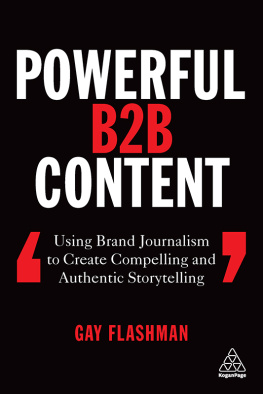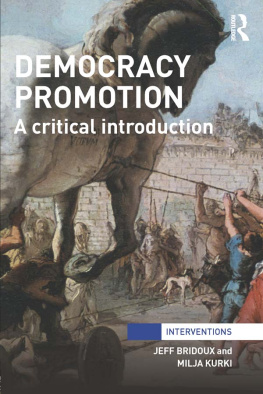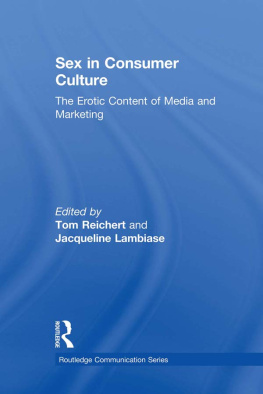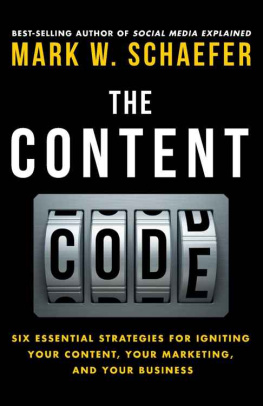
Television Brandcasting
Television Brandcasting examines U.S. televisions utility as a medium for branded storytelling. It investigates the current and historical role that television content, promotion, and hybrids of the two have played in disseminating brand messaging and influencing consumer decision-making. Juxtaposing the current period of transition with that of the 1950s1960s, Jennifer Gillan outlines how in each era new technologies unsettled entrenched business models, an emergent viewing platform threatened to undermine an established one, and content providers worried over the behavior of once-dependable audiences. The anxieties led to storytelling, promotion, and advertising experiments, including the Disneyland series, embedded rock music videos in Ozzie & Harriet, credit sequence brand integration, Modern Familys parent company promotion episodes, second screen initiatives, and social TV experiments. Offering contemporary and classic examples from the American Broadcasting Company, Disney Channel, ABC Family, and Showtime, alongside series such as Bewitched, Leave It to Beaver, Laverne & Shirley, and Pretty Little Liars, individual chapters focus on brandcasting at the level of the television series, network schedule, Blu-ray/DVD/Digital combo pack, promotional short, cause marketing campaign, and across social media.
In this follow-up to her successful previous book, Television and New Media: Must-Click TV, Gillan provides vital insights into televisions role in the expansion of a brand-centric U.S. culture.
Jennifer Gillan is Professor of English and Media Studies at Bentley University. She is the author of Television and New Media: Must-Click TV (Routledge 2010). Gillans articles have appeared in Cinema Journal, American Literature, Arizona Quarterly, Duke Journal of Gender Law & Policy, Columbia Journal of Gender & Law, African American Review, American Drama, and Mosaic. She has co-edited four award-winning literature anthologies Unsettling America, Identity Lessons, and Growing Up Ethnic in America, from Penguin Books, and Italian American Writers on New Jersey, from Rutgers University Press.
First published 2015
by Routledge
711 Third Avenue, New York, NY 10017
and by Routledge
2 Park Square, Milton Park, Abingdon, Oxon OX14 4RN
Routledge is an imprint of the Taylor & Francis Group, an informa business
2015 Taylor & Francis
The right of Jennifer Gillan to be identified as author of this work has been asserted by her in accordance with sections 77 and 78 of the Copyright, Designs and Patents Act 1988.
All rights reserved. No part of this book may be reprinted or reproduced or utilised in any form or by any electronic, mechanical, or other means, now known or hereafter invented, including photocopying and recording, or in any information storage or retrieval system, without permission in writing from the publishers.
Trademark notice : Product or corporate names may be trademarks or registered trademarks, and are used only for identification and explanation without intent to infringe.
Library of Congress Cataloging-in-Publication Data
Gillan, Jennifer.
Television brandcasting : the return of the content-promotion hybrid /
Jennifer Gillan.
pages cm
Includes bibliographical references and index.
1. Television broadcastingUnited States. 2. Branding (Marketing)
United States. 3. Television broadcastingTechnological innovations
United States. 4. Convergence (Telecommunication) I. Title.
HE8700.8.G55 2015
384.550688dc232014024842
ISBN: 978-0-415-84121-4 (hbk)
ISBN: 978-0-415-84122-1 (pbk)
ISBN: 978-0-203-76656-9 (ebk)
Typeset in Bembo
by Apex CoVantage, LLC
Contents
2.9 Steve Douglas, peer-ent, plays with Robbies band
in My Three Sons; Patty Duke sings with the Shindogs on her self-titled sitcom.
This project began because of the generosity of the UCLA Film and Television Archive and the International Radio and Television Society Foundation Faculty Fellowship to the Disney Impact Summit on Disney Channels Worldwide. I extend special thanks to IRTS President Joyce Tudryn, Disneys Bob Mendez, and Frank Gonzalez at Disneys Talent Development and Diversity, whose department made the funding for the event possible. As I did most of the research at UCLA, I am indebted to Mark Quigley, who ordered DVD transfers of the original versions of Ozzie & Harriet, The Mickey Mouse Club, Disneyland , and My Three Sons for me. I always enjoyed hearing his insights on midcentury television, and was eager to see what new content he had unearthed for me. I cannot say enough about how indispensible Mark is to the archives Research and Study Center and how much he helped this project develop. I am also grateful for the support from the UCLA Film & Television Archive Research Stipend, the Television Academy of Arts & Sciences Foundation faculty fellowship, and the National Association of Television Production Executives Educational Foundation. Special thanks to coordinators Nancy Robinson, Nikki Kaffee, and Greg Pitts.
As I kept falling down research rabbit holes, I must extend my apologies as well as thanks to Erica Wetter, my editor at Routledge. She encouraged me from the beginnings of this project, ushered it through production, and did it all with good cheer, great patience, and a skilled hand. The ever-efficient Simon Jacobs made his best efforts to keep the trains running, and was probably amazed at the ways I derailed them. I am grateful to him for his hard work and extreme patience. The whole team at Routledge has been wonderful and I thank them for all their efforts on behalf of this book. I also thank the reviewers along the way for their thinking and feedback. I developed my ideas on sustainable television in relation to my preparations for a keynote speech for Das ist Fernsehen! (This Is Television!) in Regensburg, Germany. I want to thank Judith Keilbach at Utrecht University for the invitation and the good conversation. I continued to develop my ideas in relation to a public lecture and visit to the Freie Universitt Berlin. I had the great pleasure of conversations with my host, Thomas Morsch, and his research cohort investigating Aesthetic Experience and the Dissolution of Artistic Limits through the Collaborative Research Centre. I thank them for the opportunity to share and discuss preliminary ideas. Closer to home, Tom Doherty was always willing to hear about Television Brandcasting and show support for the project. His role as respondent to a public lecture I gave very early in the writing of the sections on sponsored 1950s television was especially valuable. Over the past year, I enjoyed talking paratexts at conferences with Paul Grainge, Jonathan Gray, Cathy Johnson, Taylor Nygaard, Melanie Kohnen, Myles McNutt, and Louisa Stein. I thank the insightful audience members at previous conferences, especially at the Society for Cinema and Media Studies annual meetings. In addition to great conversation, especially about the sidekick girls of the 1960s, Lindsay Giggey generously shared her work on Connie Stevens, which is mentioned here in . I look forward to reading her ABC/Warner Brothers book one day.
Bentley University has been very generous in its support of this project with a faculty fellowship from the Valente Center for Arts & Sciences and grants from the Deans Office and the Faculty Affairs Committee. Thanks to Dan Everett, Vicki Lafarge, Juliet Gainsborough, Chris Beneke, Linda McJannet, Wiley Davi, Anna Siomopoulos, and the English and Media Studies Department grants committees. For support plus extreme patience with my need to go into hiding to finish this book, I want to single out Wiley Davi and Kathy Sheehan. For 201314, I was lucky to have my courses filled with many repeat customers. These students made the process of the final stages of reworking my ideas so much easier because the class discussions were a pleasure to lead, even when they always led back to True Detective . I formulated some early ideas about Ozzie Nelson for the chapter, From Ozzie Nelson to Ozzy Osbourne: the Genesis and Development of the Reality (Star) Sitcom, in Understanding Reality Television (Routledge 2004). I want to thank the editors, Su Holmes and Deborah Jermyn, for the opportunity. While I do no more than mention Veronica Mars in this book, I want to express my thanks to Louisa Stein and Sharon Marie Ross for publishing, Fashion Sleuths and Aerie Girls: Veronica Mars Fan Forums and Network Strategies of Fan Address, in Teen Television (McFarland 2008). The chapters focus on channel branding and series-related Television Without Pity fan forums started me thinking about connected viewing in the television industry more generally. An earlier iteration of my thoughts on Kodak sponsorship and Mad -vertising began in Kodak, Jack and Coke: Advertising and Mad -vertising on Mad Men , in Analyzing Mad Men: Critical Essays on the Series , ed. Scott Stod-dart (McFarland 2011). Some of the ideas from the Saving Mr. Banks section of come from a review essay I wrote on the film for Journal of American History 101, no. 1 (June 2014).








